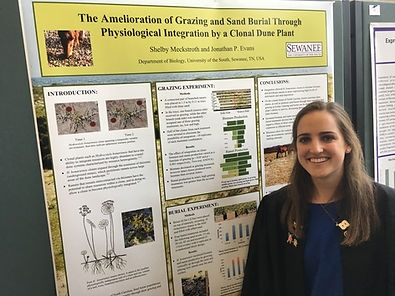
Population Ecology of Hydrocotyle bonariensis in Coastal Dunes
We have used Hydrocotyle bonariensis as a model clonal species to examine the adaptive significance of resource integration and morhophological plasticity in environments where resources are patchy in space and/or in time such as found in coastal dune systems. Hydrocotyle can form large clones consisting of thousands of interconnected ramets spaning over 40 square meters of dune habitat. Using experiments that compared severed to intact clones grown across multiple resource gradients, similar to those present in dunes, we found that resource integration conferred a net benefit to clones grown in heterogeneous environments as measured by paramets associated with genet fitness. Within Hydrocotyle clones, the structure and functioning of an individual ramet was determined by: 1) the response of that ramet to its local environment and 2) its response to resource integration within the clone. Additional experiments showed that physiological integration also ameliorated the effects of sand burial and soil salinity.


In a recent paper, we demonstrated how physiological integration allows Hydrocotyle to ameliorate the effects of grazing by feral horse in coastal dunes.
Publications:
-
Evans, J., *S. Meckstroth, and J. Garai. 2023. The amelioration of grazing through physiological integration by a clonal dune plant. Plants 12(4):724.
-
Cain, M.L., S. Subler, J.P. Evans., M-J. Fortin. 1999. Sampling spatial and temporal variation in soil nitrogen availability. Oecologia 118:397-404.
-
Cain, M.L., *D.A. Dudle, and J.P. Evans. 1996. Spatial models of foraging in clonal plant species. American Journal of Botany 83:76-85.
-
Evans, J.P. and M.L. Cain. 1995. A spatially explicit test of foraging behavior in a clonal plant. Ecology 76:1147-1155.
-
Evans, J.P. 1992. Seedling establishment and genet recruitment in a population of a clonal dune perennial, Hydrocotyle bonariensis. In: Barrier Island Ecology of the Mid-Atlantic Coast: A Symposium. C.A. Cole and K. Turner (eds.). NPS Technical Report. Atlanta, GA. pp. 75-84.
-
Evans, J.P. and *S. Whitney. 1992. Clonal integration across a salt gradient by a non-halophyte, Hydrocotyle bonariensis. American Journal of Botany 79:1344-1347.
-
Evans, J.P. 1992. The effect of local resource availability and clonal integration on ramet functional morphology in Hydrocotyle bonariensis. Oecologia 89:265-276.
-
Evans, J.P. 1991. The effect of resource integration on fitness-related traits in a clonal dune perennial, Hydrocotyle bonariensis. Oecologia 86:268-275.
-
Evans, J.P. 1988. Nitrogen translocation in the clonal dune perennial, Hydrocotyle bonariensis. Oecologia 77:64-68.


We have also shown that Hydrocotyle exhibits a unique behavior associated with rhizome growth that allows it actively avoid patches of interspecific competition. This work (Evans and Cain 1995) is often cited as one of the seminal papers associated with the new emerging field of "plant behavior and intelligence."








